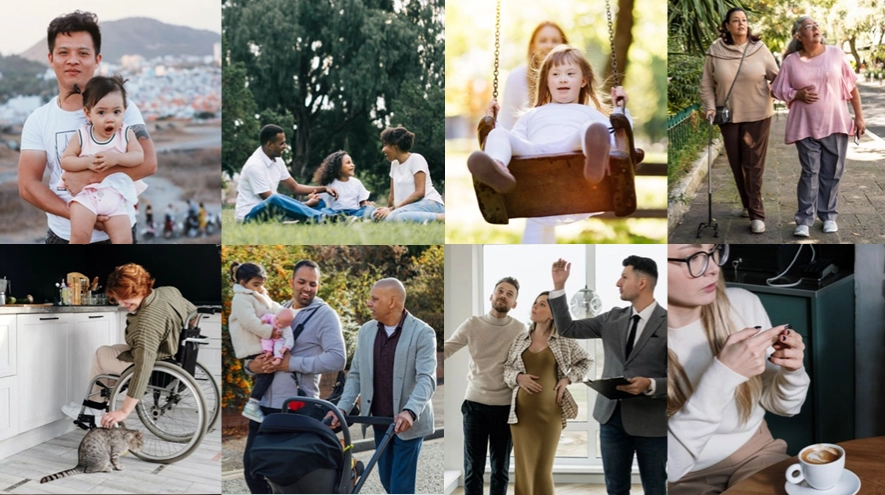The RIBA Inclusive Design Overlay - A How to for Architects
As human rights face increasing challenges across the world, the importance of creating environments that welcome everyone has never been more urgent. The role of an Architect has always been expansive, and as awareness and understanding has grown over global issues, the profession has rightly evolved to address how the built environment can mitigate these issues of our time. Much of our collective efforts have (rightly) focused on reducing the construction industry’s impact on global warming, and as such the climate crisis has long been at the front and centre of the conversation around sustainability. But in doing so, inclusive design has often been sidelined, seen as a "softer" aspect of sustainability. In reality, inclusive design is a cornerstone of sustainable communities. After all, what good are energy-efficient buildings if the people using them don’t feel welcome, safe, or able to belong?

This shift in understanding has recently been recognised by the Architects Registration Board (ARB), which updated its Code of Conduct to explicitly include Equality, Diversity, and Inclusion (EDI).
Architects are now expected to:
‘Have a committed approach to equality, diversity and inclusion in their approach to designing environments and in their relationships with colleagues, employees, clients and communities’
This means that EDI is no longer an aspirational add on for Architects, and the practice of inclusive design is the key to ensuring that EDI is integrated into the design process. In this partner piece, Architect and inclusive design advocate Nadia Malekian, shares with us a 'how to' for architects in applying the RIBA Inclusive Design Overlay.
What is inclusive design?
To understand inclusive design, we need to start with the Equality Act 2010, a law that protects all of us from direct and indirect discrimination and unfair treatment, based on nine protected characteristics of: age, disability, gender reassignment, marriage and civil partnership, pregnancy and maternity, race, religion or belief, sex, and sexual orientation. Inclusive design works to uphold the Equality Act by designing places and spaces that welcome everyone, by specifically addressing the needs of those with the protected characteristics. By designing for the marginalised, we design for everyone. Inclusive design is about removing those barriers to inclusion (whether physical, operational or digital) by creating places and spaces that enable equitable, enjoyable and independent participation.
The RIBA Inclusive Design Overlay (2023) becomes an essential tool for Architects, Design Leads and Project Managers to ensure that Inclusive Design is embedded within the design process from day one. It is a supplementary document designed to be used in conjunction with the RIBA Plan of Work, so that there is a clarity as to how inclusive design can be integrated at each RIBA Work Stage. The central tenet of the RIBA Inclusive Design Overlay is that designing inclusively is about designing for everyone, but is only achieved when you design with everyone. This means that in order to design truly inclusive environments, multiple perspectives should be included in the design process from the onset and throughout. The overlay helps with this by carving out the role of an Inclusive Design Lead, whose role is to ensure the project is designed to be as inclusive as possible by placing people at the heart of the design process.
This role can be fulfilled by:
- An Inclusive Design Consultant (external to the design team), or
- An Inclusive Design Champion (a trained member within the team)
At Mima, we support both approaches. Whether you're looking to train someone in-house or bring in external expertise, we’re here to help ensure inclusive design isn’t just an afterthought, but a fundamental part of your process from the start.
How to use the overlay: a stage by stage guide
We have worked to simplify the advice set out in the Overlay, to demonstrate in simple terms how Architects and Project Managers can use it to integrate inclusive design in their process.
Stage 0: Strategic Definition; Stage 1: Preparation and Briefing
These early stages are typically client-led, but it’s a key opportunity to influence the brief.
- Look out for whether the client has an Inclusive Design Strategy, and if not, it is at this point where the Architect can help shape it.
- Stage 1 is where the client should be encouraged to appoint an Inclusive Design Lead, who will develop a user and communication strategy to embed inclusivity throughout the project.
- When bidding for the job, we encourage Architects to collaborate with Inclusive Designers, to ensure that there is space carved out for the role at the onset of a project - i.e. include a fee for an external Inclusive Design Consultant in your appointment, or include Inclusive Design within your scope of services (if you have undertaken the appropriate training). This strategy encourages the client to see Inclusive Design as a non negotiable rather than a desirable.
Stage 2: Concept Design
At this Stage, the Inclusive Design Lead should be integrated with the wider Design team.
- The Inclusive Design Lead will establish engagement sessions with lived experience user groups.
- The Inclusive Design Strategy will be refined to establish which best practice standards will be used as benchmarks, ensuring that there is a mix of measurable and aspirational design outcomes.
- The Architect/Project Managers role here is to ensure that there is effective communication and application of these goals among the wider Design team.
Stage 3: Spatial Coordination; Stage 4: Technical Design
These are the stages where the bulk of the drawing package is produced, so it's crucial to stay aligned with inclusive design goals.
- Keep referring to the Inclusive Design Strategy to ensure that the goals are being met, and any inclusive constraints not mitigated should be communicated with the client.
- Conduct inclusive design reviews before the planning, building warrant, and construction issue submissions, in collaboration with the Inclusive Design Lead and in consultation with the User Group, to ensure best practice is applied and regulations adhered to.
- There should be a handover strategy with the Design Team to ensure any documents produced at these stages are presented in an accessible and inclusive manner.
- Confirm the requirements for the Building User Guide, ensuring that the format is accessible and when considering operability ensure a diverse user group is consulted.
Stage 5: Manufacturing and Construction
The Inclusive Design intent must be correctly implemented on site, so the execution matters.
- Ensure clear communication of the Inclusive Design Strategy with the contractor, and on site inspections.
- The Inclusive Design Lead may undertake an inclusive design audit of the building, mid-build and pre-completion, and provide report against the Inclusive Design Strategy, which the Architect/ Project Manager can support.
Stage 6: Handover; Stage 7: In Use
These stages involve careful reflection, continued engagement with User Groups, and clear communication after the completion of the build.
- Have ‘lessons learned’ Inclusive Design reviews to assess what worked and what could be improved.
- Conduct an Inclusive Design Audit of the building with the User Groups.
- Ensure that the Building User Guide accurately reflects the inclusive design measures implemented and is in a format that is accessible.
- The Inclusive Design Lead may conduct post occupancy evaluations, the findings of which should then be used to inform future projects.
Final words
In summary, this overlay should not be used as a checklist; it represents a necessary evolution of the Architect's role and provides a framework for how to implement and prioritise inclusive design throughout the entire design process. The RIBA Inclusive Design Overlay helps us move beyond compliance and toward genuinely inclusive, equitable environments. When we prioritise Inclusive Design from the beginning, in both a technical and holistic sense, we create buildings and places that don’t just function well, but truly make space for everyone. If you're looking to integrate inclusive design into your practice, we're here to help - whether through auditing, training, strategy and standards creation, consultancy, or collaborative project work with lived experience users. Together, we can build better, fairer places for all.
Partner piece written by: Nadia Malekian
Nadia is an Architect with a strong passion for socially sustainable design. She has worked in architecture practices in Stockholm and Glasgow, and last year relocated to Copenhagen to learn from a city that inspires her. She has received training in Inclusive Design and has experience in integrating inclusive design principles; in the transformation of existing buildings, research projects and in new social housing developments. She is also a volunteering member of the non profit organisation 'Building Diversity' in Copenhagen, and is a practicing Artist who specialises in screenprint. Follow Nadia on LinkedIn here.
